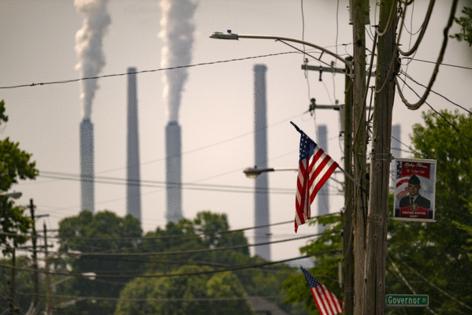Liam Denning: Coal-powered AI robots are a dirty fantasy
Published in Op Eds
The same day President Donald Trump launched his AI Action Plan, his Energy Secretary Chris Wright pulled federal support for a power project with ties to renewable energy that could help that plan. Not coincidentally, Trump instructed Wright at his AI summit that he must say “clean, beautiful” before any mention of the word “coal” and that the U.S. must compete with China’s construction of new coal-fired plants.
Possibly the only thing more bizarre than Trump’s enforced catch-phrasing is his vision of 21st century robots running on a power technology that hasn’t been cutting-edge since the days of Thomas Edison. Coal has long been a political prop for Trump, but this has taken on greater significance in his second term, with a naked assault on both the regulation of greenhouse gas emissions and zero-carbon technologies (nuclear power excepted). When coal isn’t being touted as beautiful or clean, it is pitched as reliable and cheap, and due for a comeback if freed from overbearing rules.
This is a fantasy, and a bleak one at that, not just for the climate but also that AI plan.
You don’t need a conspiracy theory to explain coal’s decline in the U.S. It lost 31 percentage points of market share in U.S. power generation between 2005 and 2024, and natural gas picked up four-fifths of that. Why? Gas got cheaper. Five times the cost of coal in 2005, on an energy-equivalent basis, that gap was all but erased by booming shale supply (which Trump also backs). Meanwhile, the cost of building new coal plants, already a multiple of that for gas, went up even as it went down for gas (and renewables). Coal’s decline was well established by 2015, when former President Barack Obama unveiled his Clean Power Plan — which was never implemented anyway.
The problem is straightforward: Coal-power is an old technology outmatched by newer ones. The average coal-plant running today began operating when Jimmy Carter was president. The youngest, Sandy Creek in Texas, came online in 2014. By 2020, its owners were reportedly in debt restructuring talks and the following year the plant tripped offline in Texas’ winter blackouts. Utilization, or the proportion of the year it actually runs, has slumped.
The cheapest existing coal plants remain competitive, according to Lazard Inc.’s latest analysis of levelized costs. Yet they are hardly a slam-dunk compared with gas or unsubsidized wind and solar. The latter are intermittent, of course, and securing firm power to back them up, such as contracting with a gas peaker-plant or battery, boosts their cost considerably. Even then, new coal is in a similar cost range — and that is only with the implicit subsidy of spewing unpriced carbon. (1)
This shows why rising forecasts of power demand, stoking fears of dark datacenters or blackouts, offer a lifeline to some existing coal plants that would otherwise retire. But this won’t catalyze new ones, even when you consider the suddenly rising cost of new gas plants. Utility NextEra Energy Inc. recently cited a levelized cost for new gas-power of $90-$115 per megawatt-hour. That would put it closer to new coal, but there are reasons why there’s a backlog for turbines, not for boilers.
Gas plants are more efficient than coal, especially in ramping up and down to match shifting demand and output from renewables, and also emit about half as much carbon. The whiplash of U.S. energy policy over the past decade demonstrates why a developer must think in terms of not the next three years but the next 30. Similarly, AI hyperscalers are prioritizing sheer speed over net-zero now, but tethering their reputations to coal over the long term would be inadvisable.
This is why, for all of coal’s vaunted qualities, the Trump administration still tries to tilt the field so heavily toward it and away from renewable competitors. Wright has made extensive use of federal powers to keep coal plants running that might otherwise close or run minimally; roughly a fifth of all such emergency orders since 2000 have been issued this year.
Similarly, Wright’s decision to pull an agreed $4.9 billion federal loan-guarantee for the 800-mile Grain Belt Express transmission line reeks of politics, rather than the economic analysis his department claims. The project, bringing wind and solar power from the Great Plains to states further east, had secured approval from four states, partly due to expected cost savings, as well as court victories over opponents. However, Sen. Josh Hawley of Missouri, a big coal-power state across which part of the line would stretch, has made a crusade out of the project’s eminent domain disputes with several dozen landowners. Recasting this as stopping a “green scam” in a conversation with Trump and Wright seems to have tipped the balance; Wright pulled the guarantee less than two weeks later.
This sort of rug-pull makes a mockery of Trump’s “national energy emergency.” Developers like renewables because they are quick to build and, twinned with batteries or gas, offer a path to a cleaner, more resilient and diversified grid. Wright’s own department forecasts wind and solar to account for virtually all additions to generating capacity this year. Trump’s call to compete with China’s coal-plant construction is laughably anachronistic. Even there, coal’s share of output has fallen over the past 20 years while wind and solar have risen from virtually zero to 18%. Last year alone, China added more solar capacity than America’s entire installations to date. Beijing presumably isn’t doing that to destroy its own grid. Rather, its clean-tech effort is driven by the new ESG: Economics, security and geopolitics.
The Republican project to protect fossil fuels and choke off the fastest-growing source of new capacity amid rising demand, meanwhile, will ultimately constrain the U.S. grid, raising costs and curtailing our AI ambitions. And it still won’t reverse decades of economic trends burying coal. Yet Trump and his cohort appear beyond such reasoning, preferring the blunt instruments of bureaucracy. If you are invested in the belief that renewables’ success owes everything to a woke conspiracy, you may well convince yourself that coal can simply be willed back to life.
____
(1) Lazard estimates new coal-fired power including a carbon price of $40-$60 per ton has a levelized cost of $108-$249 per megawatt-hour.
____
This column reflects the personal views of the author and does not necessarily reflect the opinion of the editorial board or Bloomberg LP and its owners.
Liam Denning is a Bloomberg Opinion columnist covering energy. A former banker, he edited the Wall Street Journal’s Heard on the Street column and wrote the Financial Times’s Lex column.
©2025 Bloomberg L.P. Visit bloomberg.com/opinion. Distributed by Tribune Content Agency, LLC.

























































Comments